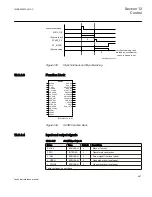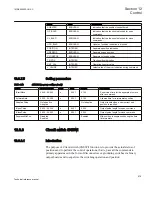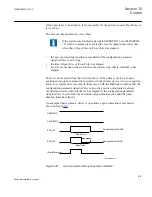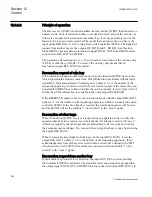
12.3.7.2
Principle of operation
The users of the Circuit breaker function (SXCBR) is other functions such as for
example, switch controller, protection functions, autorecloser function or an IEC 61850
client residing in another IED or the operator place. This switch function executes
commands, evaluates block conditions and evaluates different time supervision
conditions. Only if all conditions indicate a switch operation to be allowed, the
function performs the execution command. In case of erroneous conditions, the
function indicates an appropriate "cause" value.
SXCBR has an operation counter for closing and opening commands. The counter
value can be read remotely from the operator place. The value is reset from a binary
input or remotely from the operator place by configuring a signal from the Single Point
Generic Control 8 signals (SPC8GGIO) for example.
Local/Remote switch
One binary input signal LR_SWI is included in SXCBR to indicate the local/remote
switch position from switchyard provided via the I/O board. If this signal is set to
TRUE it means that change of position is allowed only from switchyard level. If the
signal is set to FALSE it means that command from IED or higher level is permitted.
When the signal is set to TRUE all commands (for change of position) from internal
IED clients are rejected, even trip commands from protection functions are rejected.
The functionality of the local/remote switch is described in figure
From I/O
switchLR
TRU
E
FALS
E
Local= Operation at
switch yard level
Remote= Operation at
IED or higher level
en05000096.vsd
IEC05000096 V1 EN
Figure 337:
Local/Remote switch
Blocking principles
SXCBR includes several blocking principles. The basic principle for all blocking
signals is that they will affect commands from all other clients for example, operators
place, protection functions, autoreclosure and so on.
The IEC 61850 communication has always priority over binary inputs,
e.g. a block command on binary inputs will not prevent commands over
IEC 61850.
Section 12
1MRK505222-UUS C
Control
670
Technical reference manual
Summary of Contents for Relion 670 series
Page 1: ...Relion 670 series Line differential protection RED670 ANSI Technical reference manual...
Page 2: ......
Page 40: ...34...
Page 50: ...44...
Page 60: ...54...
Page 126: ...120...
Page 384: ...378...
Page 496: ...490...
Page 556: ...550...
Page 602: ...596...
Page 620: ...614...
Page 794: ...788...
Page 864: ...858...
Page 988: ...982...
Page 998: ...992...
Page 1084: ...1078...
Page 1164: ...1158...
Page 1168: ...1162...
Page 1220: ...1214...
Page 1230: ...1224...
Page 1231: ...1225...










































